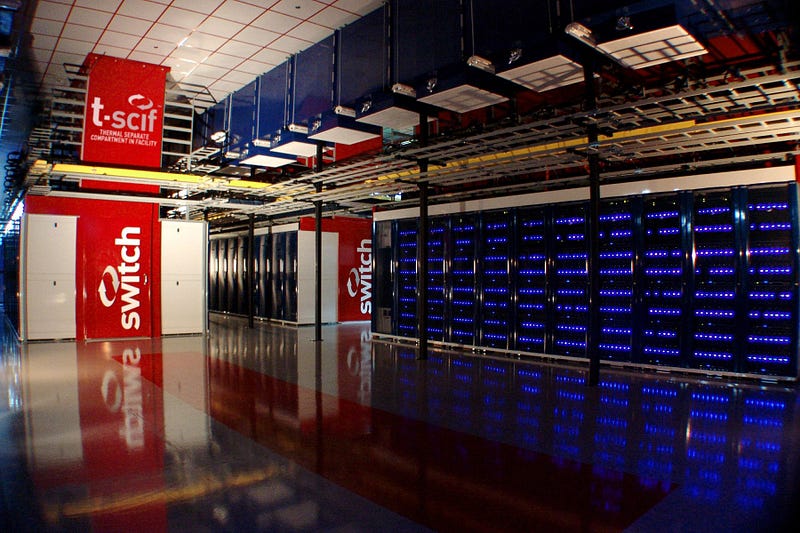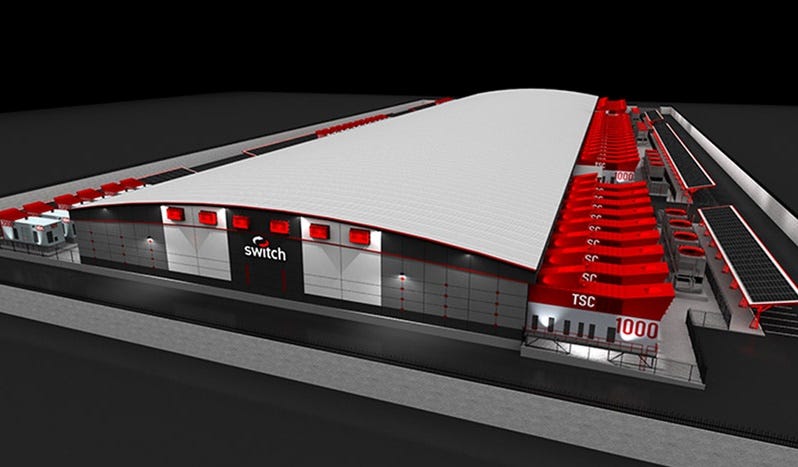Switch, a data center operator and innovator, proposed a new campus in West Michigan. We see big opportunity for business and talent in the region.
As a curious person, I am watching the news around the Switch proposal closely. You may be aware that Switch, a Nevada-based firm, wants to acquire the former Steelcase pyramid, which is a 600,000 square-foot office space in West Michigan. They plan to build a $5 billion data center.
Switch would replicate its two other campuses in Las Vegas and Tahoe Reno here in Grand Rapids. With a little Internet research, you will see clearly that Switch’s data centers (called “SuperNAP”) look like something out of an Iron Man comic book. The bright colors, military security guards, vast scale, 100% uptime offer, and techie-ness of it all are amazing. It’s done with a specific purpose in mind: to give the biggest and best companies the confidence to host their critical systems in a SuperNAP facility.

West Michigan attracted Switch with its geologic stability and central position between major business hubs. From Grand Rapids, Switch can send and receive data to Chicago within 2 milliseconds and to New York within 14 milliseconds. All that appears to stand in the way of the development is a request for tax incentives similar to those in North Carolina or New York, other locations in the running for the new data center.
I’m not an expert on data centers; however, I do have a pretty good understanding of the technology at play, how it continues to evolve, and what that means for organizations like my firm. I’m not going to discuss the appropriateness of the changes in tax code to close the deal. Instead, I believe there is a wonderful opportunity to make big strides in West Michigan’s reputation as technology center.
I remember seeing my first data center back at Priority Health, a local health insurance provider. It was built on-site with help from IBM with raised floors, special cooling systems, high security, and a giant backup power generator. Standing in the middle, surrounded by empty racks, you could feel the cold air move your hair as if you were riding a bike outside on a cold day. A large room outside the data center was filled with multiple screens to watch everything going on. At the time, our IT department felt a lot of pride in this advancement. This was going to make our applications run faster, provide more uptime (99%), and give us capabilities we didn’t have before. We felt modern, maybe a little leading edge, with our technology.
Looking back, we had a bit of an arrogant streak in thinking we knew technology better than anyone else. It took me leaving and working for other companies to learn how this viewpoint actually hurt us in our decision processes. Just one thing about this new data center caused some nervousness. It was located on-campus and didn’t have any redundancy if someone was to take out the whole block where we worked.
Furniture manufacturer, Herman Miller, introduced me to my next big data center. This was a very secure facility right in the middle of the IT department. I remember my tour and being particularly enamored with the sticky floor mat that you could peel away like a giant post-it note. Being the father of two young children at the time, I always wanted something like that for my home to keep my floors somewhat clean.
This data center had a big weakness that we discovered when an electrician shorted an electrical panel where the main and backup power ran through together. The whole data center shut down and sent an IT team scrambling to figure out what happened and how to bring all the systems back online. It also shut down production leading to a whole shift being sent home. For all the time and effort Herman Miller put into a data center to handle their critical systems, they missed that one key piece.

Fast forward to today. We live in a world that is increasingly software driven. Our applications run in the “cloud” on distant data center spread across the world using Amazon Web Services, Microsoft Azure, or other providers. Consumers and businesses are using more and more applications on mobile devices. The development of technology for the great cell phone race has lead to advancements in cooling, power consumption, redundancy, and performance. These advancements have the effect of commoditizing the systems used in data centers. Companies that used to build, update, and run their own data centers can now outsource all that activity to a data center like that being proposed by Switch.
The economics of the “cloud” and vendor data centers are such that the total cost of ownership is becoming cheaper to have your critical systems there than to own your own private data center. I am including the cost for licensing the software as well as the cost for staffing data centers, keeping that talent trained on the latest advancements in technology, and updating your data center as your business evolves. The only reason today for having your own data center is for very specific security/control requirements, but even these concerns will eventually be resolved by large organizations like Amazon as they scale their businesses into the enterprise.
One thing that is important to notice with Switch’s SuperNAP, this isn’t just a data center. This is a Fort Knox facility that offers 100% guaranteed uptime. They have ultra-efficient, uninterruptible ways to cool the equipment. They have roofs above roofs, so there will be no leaks of water into their facility. They own 218 patents, which apply to everything from heating and cooling, to sensor systems, to power management, and even to the building themselves. With a data center like this, you can locate your equipment there and not lose sleep that a giant snowstorm is going to take down your systems.
What excites me most with the Switch proposal is the technology expertise and attention it will draw to West Michigan. Smart people want to work with smart people. A cutting edge technology campus will bring more smart people here to work and live in our region. Adding just 1,000 new technology experts, let alone the 3,000 or so discussed, starts to create a capability here that benefits all businesses across West Michigan. Our businesses are becoming digital enterprises driven by software algorithms and the systems they run on. A dependency exists on talented people to create, update, and manage these systems. Our challenge today is that there are not enough good talent in our job market to fill the demand that exists. The students coming out of our local colleges and universities are looking for experiences to grow and many are attracted to places where technology leadership is happening. We need to provide something exciting and leading edge to attract and keep technology talent in West Michigan.
At Springthrough, we look for unique people with a mix of technology skills, curiosity, and a capability to deliver for our clients. The market for good software developers has been extremely tight. Competition is fierce. It is even hindering the growth of smaller companies, as they can’t afford the salaries of the talent that remains. Industry leaders in West Michigan have been trying several programs to find talent and keep the talent being developed here from leaving. I’ve seen good software developers move out to the West Coast looking for new opportunities to grow. Opportunities like the Switch proposal are rare for Michigan and needed. With something like this, I’m positive it will only bring good things to companies like Springthrough and our clients who depend on us.


